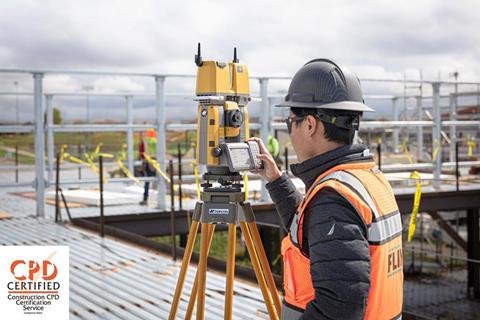
Sponsored by Topcon Positioning GB, this module will explore the benefits of digital workflow technology, alongside the issues that may arise during integration and how they can be overcome

Technology adoption was accelerated by the pandemic, which pushed digital solutions from an asset to a necessity. Now, as difficult market conditions put a strain on margins and an emphasis on efficiency, contractors are forced to assess whether their current technology continues to meet their evolving needs.
Digital workflow solutions may seem like a big shift, but they can be a game-changer for those looking to streamline their job sites and build a more productive, accurate and cost-effective way of working.
Learning objectives
- Understand how digital workflow systems operate and the potential benefits they bring to a project
- Awareness of the problems that can arise during integration and how they can be overcome
With a growing skills gap, stringent sustainability requirements and tighter margins putting increasing pressure on the built environment sector, there is more demand for new technology – and better use of current technology – to improve efficiencies across operations.
Giving site managers more data to hand, digital workflow platforms bring together all aspects of a project, both on- and offsite, to provide a picture of how the build is progressing. Whether sending data to machine control systems for future tasks, or collating positioning data to ensure that a project is progressing to plan, digital workflows ensure that the insights on offer help rather than hinder collaboration.
All that is missing is the consistent onboarding of solutions – whether it’s the hardware making data collection faster and more accurate, or data management tools helping to make that data interpretable and more useful for those who need it on the ground.
These systems are rarely a one-size-fits-all solution – they work best when tailored to a business or project. It is often possible to put together modules designed for specific applications, and this should be front-of-mind when choosing a platform, with the intended task leading the technology adoption.
Staying connected
From the initial planning stage of a project, digital workflow solutions enable more effective collaboration. Cloud-based platforms can bring together colleagues working from home, the office or job site, enabling the sharing of information from multiple locations simultaneously.
Creating a cloud-based plan makes monitoring progress, budgets and various tasks simple and ensures everyone is on the same page. Live digital plans can be submitted to the relevant authorities so that they can see the latest version and having updated constructible models for the field ensures the as-built is as-planned.
In the dynamic environment of a large-scale project, digital workflows bring advantages once work begins too. Project stakeholders have less need to be on site because digital site management solutions can provide a live dashboard view of the project area. When decision-makers need to act quickly, they can do so with all the relevant project data at their fingertips, displayed on an intuitive user interface.
For heavy earth moving equipment, such as bulldozers and excavators, fitted with automated machine control systems, the responsibility for accuracy and speed is in the hands of performance-enhancing technology. Operators receive real-time, dynamic, on-screen bucket and blade location and updated design model views. The technology can then feed back on work progress directly to site managers. Access to real-time designs means that operators can cut more accurately and check against complex designs in the cab, removing the need for other staff to check the grade and design. This ultimately reduces the potential for rework and improves health and safety on site.
Doing more with less
Boosting efficiency is vital for construction companies looking to weather the storm of rising costs, and being able to manage their sites is a first step towards achieving it. With digital site management, the accuracy of work can be more closely monitored, and any problems spotted and fixed sooner.
It is here that digital workflows work best with machine control solutions. This combination can cut human error down to almost zero, and the remainder can be addressed quickly and efficiently. Moreover, the ability to instantly share the latest plans with everyone on site makes it easier to implement changes during the project.
That said, unexpected issues that are beyond the control of even the best-prepared construction managers can sometimes arise. In these situations, digital workflow solutions can be of assistance, allowing projects to adapt to minimise the negative effects. For example, if a machine breaks down and cannot be repaired immediately, other machines and resources can quickly be sent to complete the job and their schedules updated accordingly.
O’Brien Contractors used machine control technology to deliver a complete relocation of the Old Saltleians Rugby Football Club when the club’s pitches and clubhouse needed to move to a new site in Water Orton, Warwickshire. Because of the vast amount of surveying, earthworks and logistics that the project involved, Topcon’s automated machine control system, MC-Max, and Sitelink3D v2 software were chosen to manage the project.
Once works had begun, the team found a difference in ground material that was not detected in the early stages of development – the layer of topsoil at the new site was significantly deeper than it had appeared on initial site surveys. O’Brien Contractors was able to add the new data into the software and plan budgets, timings and resources, automatically synching the new data to the relevant machines working on site with no delay to the plant operations.

Building green
The built environment is one of the biggest contributors to the UK’s carbon footprint, and construction is one of its most polluting industries. Companies in the sector are working hard to find areas where they can cut down on their emissions, and although going digital may not be an obvious solution, it can make a difference.
For construction companies looking to reduce the embodied carbon within their buildings, making the process as efficient as possible is a good start. Reducing the amount of materials needed on a project also reduces its carbon footprint, as does eliminating the need for rework (which cuts down on materials used as well as the emissions from machine movements).
Alun Griffiths, a civil engineering company based in south Wales, was looking for new software solutions that would help the team work more efficiently and sustainably by reducing wasted materials, errors and downtime.
Sealand Survey worked closely with the team to develop a bespoke system using machine control technologies, which enabled it to become one of the first contractors in the UK to run multiple sites remotely, using remote support, file transfer, autogenerated reports and weight reporting on haul trucks. By updating its machine control fleet, the company reduced callouts by 80% and sites are now able to work more safely, efficiently and sustainably.
Managers being able to work remotely is another big boost for a project’s sustainability credentials. The ability to do more remotely keeps fuel expenditure down and reduces emissions, as well as allowing managers to use their time more effectively due to less travel between sites.
Increasingly, more specifications require buildings to meet sustainable building standards such as BREEAM and LEED, and those in charge of awarding contracts generally have more confidence in companies with efficient and sustainable workflows.
Businesses are hesitant to invest in new technology while navigating a tricky market, and this can mean that sustainable solutions with long payback periods, or those offering incremental savings, are passed over. Digital workflows offer small individual emissions reductions for businesses – but when applied over whole workflows and projects, add up to significant totals. Moreover, not only are the initial benefits immediate, but firms can build on them further in future.
Tackling talent trouble
Construction companies are increasingly under pressure from the growing skills shortage. With experienced operators soon to be retiring and a lack of new recruits joining the industry, businesses are being left without the people they need for the job.
Fewer recruits entering the market also puts a premium on those that are coming through, and construction companies will be working hard to improve their offering in the battle for talent.
While it cannot recruit skilled talent, automation technology puts the power to complete complex work in the hands of less experienced operators, with digital site management solutions feeding the machines the data they need to do so. This reduces the number of supervisors needed on site, allowing more experienced workers to contribute elsewhere.
However, on-site construction workers have typically been resistant to move away from traditional methods, and the sector is one of the least digitalised in the world, according to the McKinsey index. To help with the challenges of adopting these technologies and encourage teams to embrace them, manufacturers offer support in choosing the right products and in training solutions for staff.
Integration
Often, a complete digital workflow will involve software from several different providers, covering different aspects of the project. This can bring challenges such as incompatible data that hinders collaboration. Integration platforms can smooth the road by allowing construction companies and project stakeholders to integrate their current office and field technology and make better use of previously siloed project data.
Integration platforms must be designed with operational best practice in mind, including industry standards around data-sharing, security and country-specific requirements to achieve a broad level of compliance across applications and functions. Potential additional users should also be a consideration when deciding on the right digital workflow platform, as should the ability to add contractors or additional stakeholders for specific projects.
Payment structures also acknowledge the variety of projects that many businesses take on, and rental schemes allow them to use a digital workflow for one project without having to commit to using it elsewhere.
It is easy to feel overwhelmed by all the digital solutions hitting the construction market, as companies work out where they fit into their operations. Digital workflow platforms work as the glue that brings all these solutions together. They are the key to unlocking a more efficient and productive future for construction.
Please fill out the form below to complete the module and receive your certificate:
















No comments yet